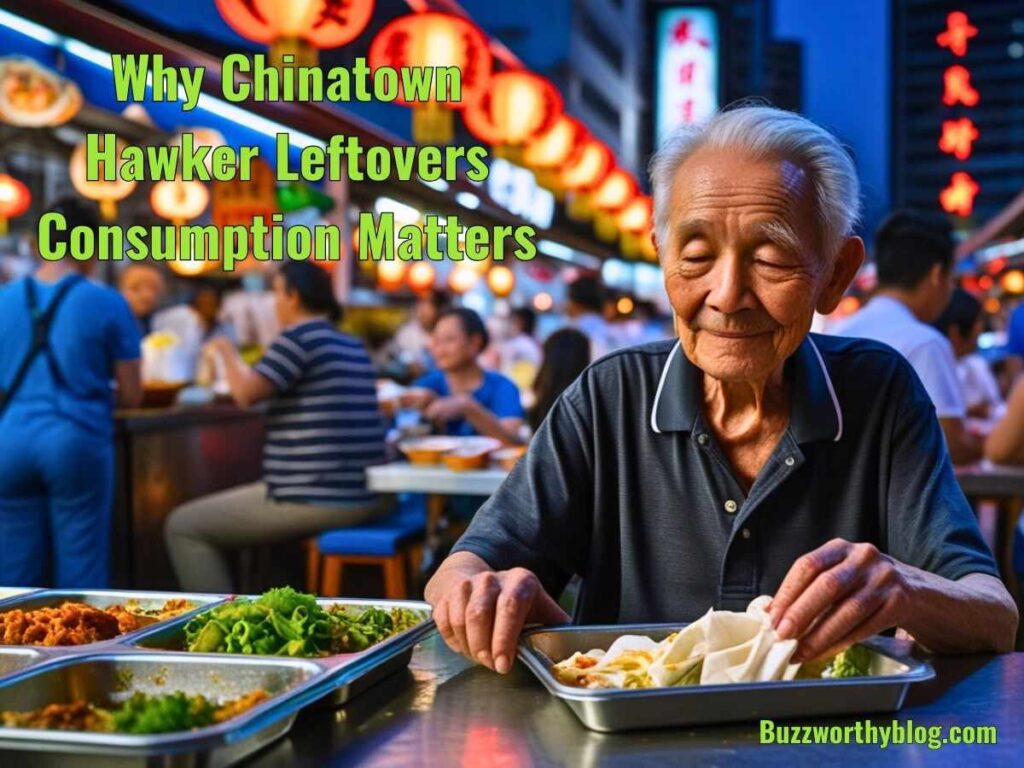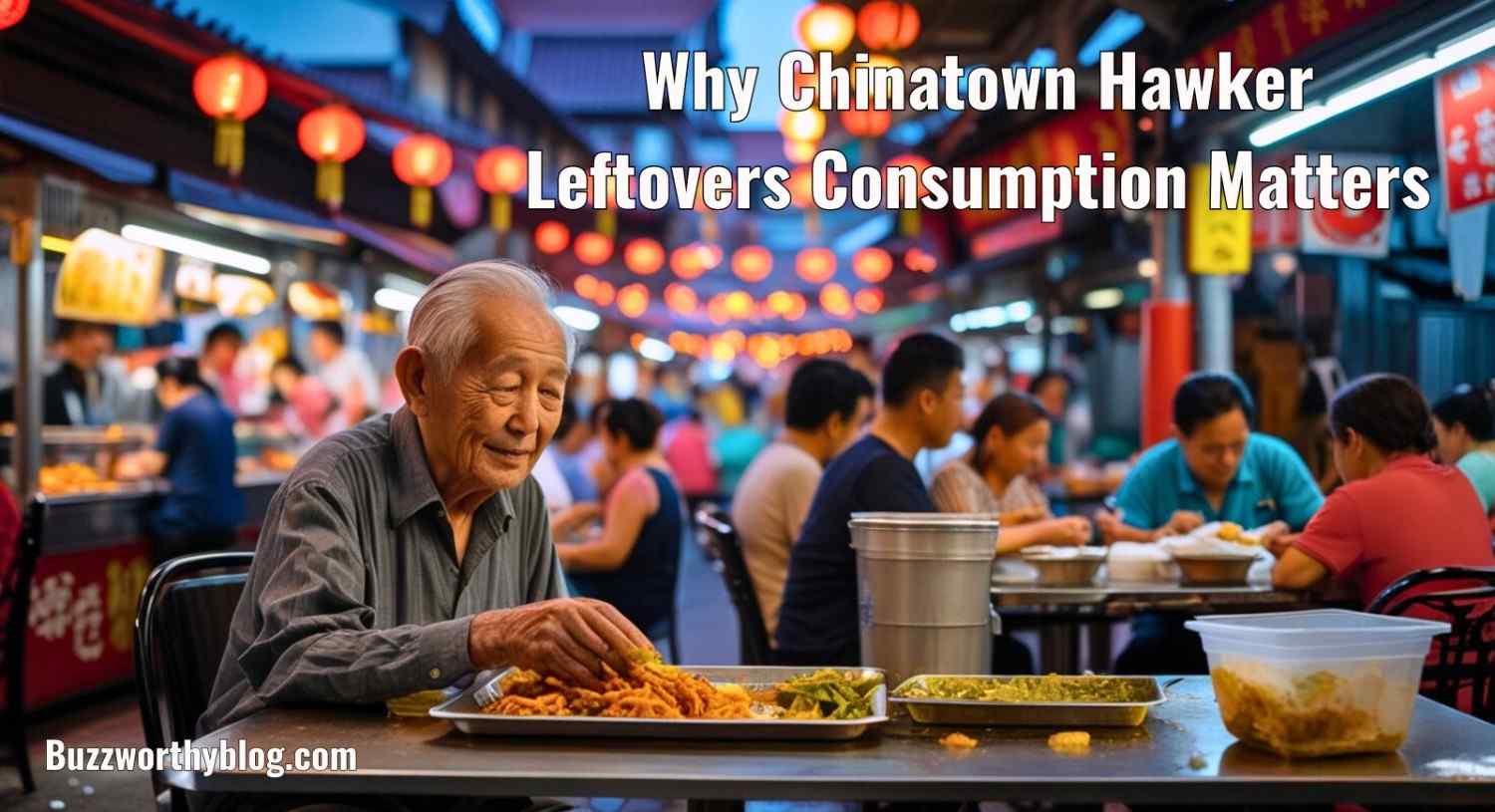Introduction
Chinatown hawker leftovers consumption should significantly impact the urban food waste issue in our community today.
Each day in food centers across Chinatown, tonnes of perfectly good food from hawker stalls are being thrown away.
Not because it is rotten, but because it is unsold.
Many in the urban population struggle to feed themselves, but trays of uneaten rice, noodles and freshly made dishes go into the trash, adding to the food waste crisis.
Come and join us as we discuss how this one little-known habit is growing into a powerful movement,
That is tackling some of the greatest challenges of sustainability and community that we face today.
Understanding the Food Waste Crisis in Urban Food Centers

Visit any Chinatown hawker center at closing time and you’ll see the sad truth: mountains of unsold but still totally serviceable food, bound for the dumpster.
Such daily overproduction spells trouble for our environment and economy.
The Hidden Environmental Cost of Daily Hawker Waste
Food waste also leads to toxic methane emissions in the landfill and financial losses for hawkers with unsold items.
Snacks that could support themselves as reasonable businesses are thrown away daily, alongside millions,
That can’t be the case as neighboring communities face food affordability issues.
Chinatown hawker leftovers eating serves the purpose of eliminating any surplus food.
That is not used or going to be consumed and fills the gap between surplus and need.
- Ecological effect: Prevents methane emissions from food waste
- Economic advantages: Provides alternate income sources for hawkers
- Resource efficacy: utilizes prepared foods to the max
- Community engagement: Offers low-cost meal options
What Is Hawker Leftovers Consumption?
Breaking the Stigma Around Surplus Food
Hawker Yet Another Possibly New Hawker Food Concept, YAPHF, it also has the dubious honour of standing for,
Yet Another Project hawkers then purchase for sale or redistribute unsold safe-to-eat meals, selling before the stall’s closing time.
These aren’t table scraps; these are usually untouched, freshly made dishes that have gone unsold during regular hours.
Unfortunately, there are still some misconceptions about eating Chinatown hawker leftovers consumption.
Leftover food is often also thought of as bad quality, or categorized as unsafe to eat, and there are cultural taboos around eating cheap, on-sale food, as a sign of poverty.
Ignorance is why these types of activities are not implemented by a larger number of people despite their apparent advantages.
Not leftovers, Surplus food is usually fresh and untouched
- Safe and sound: correct application is the most definite basis of food safety and sound
- A win-win: Good for sellers and good for customers
- Perception shift: From “leftover stigma” to “rescue value”
Health & Safety: Is It Safe to Eat Hawker Leftovers?
Food safety is at the top of everyone’s mind regarding surplus food from hawker centers, and for good reason.
Thankfully, many vendors abide by good food safety practices, so what’s left over is safe to eat.
Display must keep food in safe zones, and fast packaging is necessary immediately upon cooking to keep food fresh.
Digital verification in the form of food sharing apps can also require vendors to specify how long they’ve spent on their dish.
While participating, hawkers are beholden to certain quality benchmarks that protect consumers.
Safety Standards:
- Monitoring the temperature while in storage
- Fast packing after preparation
- Preparation times are tracked digitally
- Vendor verification systems
Sustainability Benefits of Hawker Food Rescue
Every tub of rescued hawker food serves up impressive green outcomes, not just the simple fact of averting waste.
This practice substantially reduces environmental impact by preventing methane emissions from rotting food in landfills.
There is a smaller carbon footprint associated with food production and transportation.
A Greener Approach to Urban Dining
When city dwellers engage in chinatown hawker leftovers consumption, they participate in a food economy that is more circular.
This daily act of simplicity is a significant form of accessible food activism, affordable to anyone, regardless of income or background.
This shows how what we all eat can affect real environmental change through mindful consumption, rather than the disposal of perfectly good food.
Environmental Benefits:
- It contributes towards less landfill waste and methane, not just because it is amazing, but because it is all that and more!
- Reduces the carbon footprint in food production.
- Saves water and energy
- Generates a circular food economy model
Share Hawker Food, Value and Community Culture
Cultural and Community Value of Sharing Hawker Food
Encyclopedia of Food and Agricultural Ethics: Food Sharing as Cultural Heritage Preservation
Hawker centers are the beating heart of Chinatown’s cultural identity, the places that safeguard food traditions that have been in families for generations.
Another layer of meaning is added to this cultural importance with the custom of sharing leftover meals with fellow hawkers.
Food Sharing as Cultural Heritage Preservation
Consuming leftovers from Chinatown hawkers builds social trust between hawkers and regular customers.
Facilitates cross-cultural appreciation for traditional menu items.
It enhances the economic sustainability of hawkers who maintain traditional recipes and promotes a culture of appreciation and mindfulness regarding food.
Community Initiatives:
- Pay it forward meal programs
- Fridges in the community are stocked with surplus food
- Food heritage records potential developments
- Workshops for cooking together as a family
Digital Tools Revolutionizing Food Redistribution
Technology now makes it relatively easy to match unused food with people who want to eat.
Creative apps launching in the market focusing on hawker center food rescue are becoming a hit among environmentally savvy individuals.
Visit popular outlets like Treasure (which verifies vendors and time stamps) or OLIO (the ultra-local, peer-to-peer sharing app based on community love).
Apps like Too Good To Go offer surprise bags of mystery leftovers, and SG Food Rescue organizes volunteer forces for wide-ranging distribution efforts.
Platform Features:
- Live Food availability push notifications
- Secure payment processing
- Vendor verification systems
- Monitoring the environmental impact
Discover more untold stories like this one, exploring culture, sustainability, and street food impact, only on Buzzworthy Blog. Join us in rethinking what really matters.
How You Can Participate in Hawker Food Rescue
Ready to join the movement? Here’s how you can take action to feed on Chinatown hawker leftovers consumption today.
For individuals, download food-sharing platforms that link with local hawker centers, pop by stalls in the last hour of their operations and inquire about leftovers.
They are willing to sell off at a discount; bring your tau pao (a colloquial Chinese term for take-away containers) to pack excess food.
Publicise success stories on your social media page to normalize the practice and discuss.
How can reducing such waste become a collective community responsibility within your social circle?
Practical Steps for Reducing Food Waste Today
Community groups can schedule hawker center food rescue campaigns and develop educational resources to inform about the safety of surplus food.
Connect hawkers with local shelters or community centers, and establish awards for vendors demonstrating sustainable behaviors.
Vendors can do so directly by partnering with food redistribution nonprofits, offering discounted meals at the end of the day,
advertising if they offer meals for sale via food rescue, and training staff to correctly manage and handle excess food.
Get Started Today:
- Have food rescue apps on your mobile phone
- Hit the hawker centers at closing time
- Take your own reusable containers for takeaway
- Share your memories on social media
- Initiate a dialogue on food waste
Economic Impact on Hawker Livelihoods
Apart from the environmental gains, the consumption of Chinatown hawker leftovers consumption was seen as a powerful support to an industry characterized by slim profit margins.
Hawkers usually produce food in large volumes, and a random demand forecast is often challenging.
Unsold food at the end of the day is a direct loss of revenue; money spent on ingredients, preparation hours, and utilities pays no dividends.
How Leftover Consumption Creates Financial Sustainability
A side market for this surplus is therefore created by food rescue programs, offering hawkers more money instead of none at all.
This can boost daily revenues for many operators by 5–15% and can be the difference between breaking even and profitability.
This economic robustness goes a long way in keeping traditional hawker culture intact, ensuring that vendors can ply their trade at least economically.
Economic Benefits:
- Provides vendors with a new revenue stream
- Lessens the food cost implications of wholesaler spoilage. Personally, I’d love to see food waste achieve the same new level of badness that smoking has.
- Reduction of waste removal costs
- Enhances Business Longevity
Conclusion
Chinatown hawker leftovers consumption is about much more than black-marketing foodstuffs; it’s a philosophy shift, a reassessment of what we touch.
How we touch it, and what we make of it, takes the people’s resources of a community and its collective culture.
Through this action, we take responsibility to sustain a more responsible urban food ecosystem while safeguarding the dynamism of hawker cultures.
This little action lessens the environmental impact and brings economic opportunity to vendors.
Fosters community connections and addresses food insecurity with respect.
Whether it’s care for the environment, standing behind your community or because you love good food for a great price, taking part, you are a part of something bigger.
Frequently Asked Questions
Can you eat the food left over for us in a hawker center?
Surplus hawker food is as safe as any other meals if handled and bought through official channels.
How much will I be saving by buying leftovers from the hawker?
Most surplus food is sold at a 30-50 per cent discount.
Do I have to install special apps for hawker food rescue?
Apps streamline the process, but you can also arrive at hawker centers shortly before they close.
How does eating leftovers benefit the environment?
It cuts down on methane emissions from landfills and cuts down on the resources used in food production.
Can community hubs collaborate with hawker centres?
Many facilities are open to collaborations for organized food rescue and redistribution programs.
Buzzworthy Blog delivers sharp, engaging content on tech, business, and trending topics. Our mission is to inform, inspire, and spark curiosity with every post.

